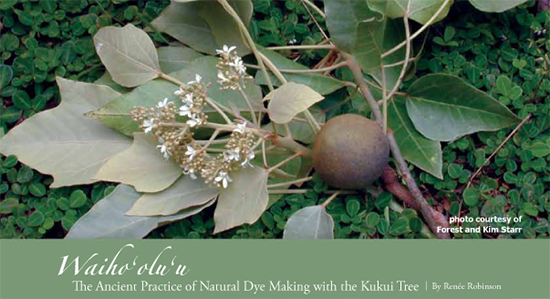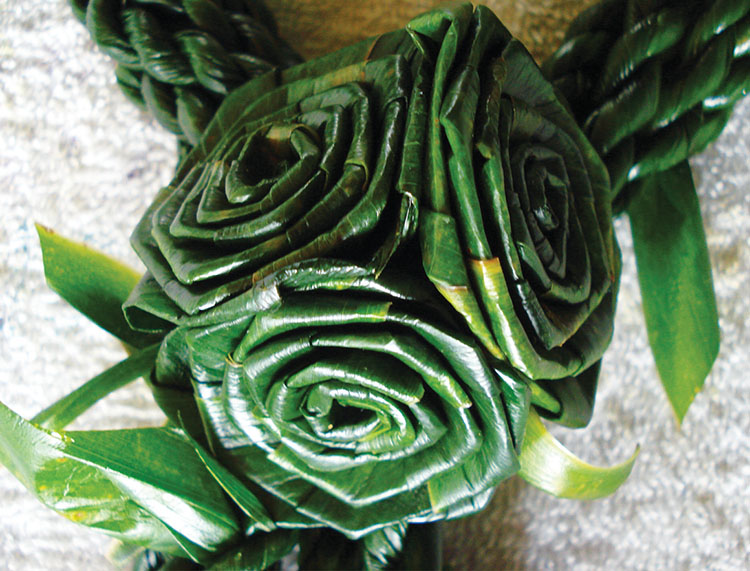
Waiho‘olu‘u: The Ancient Practice of Natural Dye Making with the Kukui Tree
By Renée Robinson
In Hawai‘i the kukui tree, distinctive in its pale green, silvery foliage, is a symbol of enlightenment, protection, and peace. Kukui (also known as candlenut) was a canoe plant. Its seeds were brought to Hawai‘i by the first Polynesian voyagers.
In old Hawai‘i, kukui nut lei were worn by the Ali‘i (royalty) to honor the life-giving force of Lono and to show their social status. For them it was like wearing a lei of light providing hope, healing, and protection.
Kukui was believed to be a physical manifestation of Lono, the Hawaiian god of agriculture and fertility. Lono appeared when abundance was ready to be harvested.
All parts of the plant were used by the early Hawaiians, and many of these traditional uses are still practiced today. The light colored wood of kukui trees was often used for canoes and fishing floats. It’s been said the fishermen would chew the nuts and spit them on the water to break the surface tension and remove reflections, giving them greater underwater visibility.
Historically, the oily nuts were burned and used like candles for indoor and outdoor lighting. The nuts were strung four or five on a stiff palm leaf mid-rib. The oil in them burned slowly and brightly providing an excellent portable light source.
The Kukui Dye Workshop
We gathered at the Amy B.H. Greenwell Ethnobotanical Gardens in Captain Cook to learn from Bernice Akamine, a Hawaiian cultural arts practitioner from O‘ahu. Throughout the day she taught us the cultural uses of the kukui tree and how to make waiho‘olu‘u (color, dye, coloring liquid). Of course, this being a hands-on workshop, we first needed to gather the materials to work with.
Plastic bags in hand, we collected kukui nuts: green ones off the tree, nuts on the ground with the dark—and sometimes yucky—outer rind, nuts, and nuts without the rind. Some people had bulging bags in a few minutes, others went to kukui trees further away. Not wanting to go back empty-handed, I used a stick to dig nuts out of the impacted dirt where the maintenance vehicles drive.
Back at the workshop tables, we sorted our gatherings: green nuts in one pan, plain nuts in another, and the dark ones in several pans.
Then we began to prepare the dye-making ingredients.
The green rinds were cut in half to free the nut. I helped separate the dark, decaying rinds from the nuts. A messy job, yet so worth it in the end. Any parchment was recycled.
Once separated, the rinds were rinsed several times, then put into two large kettles on the stove with an equal part of water to make the dye. Ours cooked for about an hour, more time would make a darker dye.
While a group of us sorted and cleaned the nuts with rinds, others used hammers or lava stones to crack the nuts and separate the meat from the hard shell. The shells were used as mulch underneath the trees. The actual nut meat went into a big foil-lined stainless steel pan. When a hammer was available, I cracked my first nut—oh my, what a stench! Apparently it had been sitting in the driveway too long and was rotten. Later Bernice said we could have used the oil from those ‘rotten’ nuts to help start the fire of the fresh nuts. Who knew? Lesson learned—everything is usable.
While I finished cracking my kukui nuts, part of the group were peeling kukui roots and exposing a beautiful red color. They scraped the peeled root with the edge of a knife and ended up with piles of red shavings. These were combined in a pot, water was added, and onto the stove it went. The longer it cooks, the deeper color the dye will have.
Ideally you’d let the cracked nuts dry for a day or two before burning them to extract the oil. Because the nuts were fresh we used a blow torch. This is where my ‘rotten’ nut oil would have helped. Once the nuts were lit, a foodservice deck pan with a smooth inside was placed over the burning nuts for about an hour. The soot collected on the inside of the pan is used to make an ink that can be used on kapa and also for body tattoos.
While the nuts were cooking, some of us peeled logs from a downed kukui tree. It was BEAUTIFUL! I wanted to take my peeled log home and use it as a piece of art. Instead, I was a good student and scraped off the red color, then added the shavings to the pot of red dye. Several attendees took the scraped logs home to use for firewood.
Near the end of the class, we dropped pieces of white cotton fabric in the pans of strained dye. Normally these would sit for a couple of hours or overnight to fully absorb the color. However, it was enough for us to see the rich dark brown, the beautiful red, and the greenish beige colors which came from our day’s work.
More Dyeing Tips
When you dye a project (fabric, ipu, kapa, paper), remember to make all the dye that you will need at one time, as many variables affect the color from batch to batch.
If you gather the red from a live kukui tree, PLEASE take the following precautions: First, only take what you need. Make strips going lengthwise on a branch. Never peel all the way around a branch or it will die. Gently scrape the color, leaving the inner bark so the tree can heal. Gather from multiple trees instead of just one. Clean and sanitize your knife blade an alcohol or disinfectant wipe between trees.
Older bark has a deeper color than new bark. If you gather the bark in the rainy season the color will be lighter, the dry season yields a darker color.
Other Uses for a Kukui Tree
- The oil is known for its healing properties and is an important ingredient today in many creams and massage oils.
- Sometimes called the varnish tree, kukui nut oil is used to varnish and preserve wood as well as to waterproof fishing nets, tapa cloth, and paper.
- The red dye is used to make fishnets less visible to fish.
- The sap from the leaves will help with gum infections.
- The sticky tree sap is used as a healing covering for wounds, mosquito bites, shingles, chickenpox, or as an adhesive gum.
- The juicy sap that fills up the depression left when the stem is pulled off the green fruit is used to treat thrush/white tongue. This sap is also a healing application for chapped lips, cold sores, and mild sunburn.
- If you’re constipated, drink a glass of water with grated green kukui nut added.
- Need to boost your immune system? Eat some of the flowers.
- The leaves and the lightly fragrant white flowers are often used in lei, as are the inch-round nuts or seeds.
The delicate flowers of the kukui tree played a role in the ancient healing practices by helping to clear the centers of the body from which a person can collect energy (chakras).
The kukui nut is not considered ideal for regular consumption. Uncooked it is quite toxic to the body. The cooked nuts are eaten in small portions, typically as a topping on other foods. Too much can cause an intestinal cleansing with a purging effect.
‘Inamona is a tasty condiment used in Hawaiian cooking made from roasted kukui nuts and Hawaiian sea salt. A serving of ‘inamona and poi was considered a full, nutritional meal. Chili peppers and seaweed can be added for more flavor.
My biggest takeaway was participating in the ‘talk story’ learning process while working with my hands. Everyone contributed as they were able—sharing in the work, and sharing in the results. What a blessed way to live. And it’s fun to recognize the green, silver leaves as I drive around Hawai‘i Island.
Kukui trees grow quickly with male and female blossoms on the same plant. Its stately size, rounded, spreading crown, seasonal inflorescence and silvery-lobed leaves add a unique beauty to any property. Adding to the appeal of growing kukui trees is the ease of maintaining them. Though they prefer a steady supply of water, they can tolerate lengthy dry periods. They have few pests and need only light pruning when young to ensure a desired canopy shape.
Is it time to plant a kukui tree on your property? They are available at Amy B.H. Greenwell Ethnobotanical Garden as well as several local nurseries.


